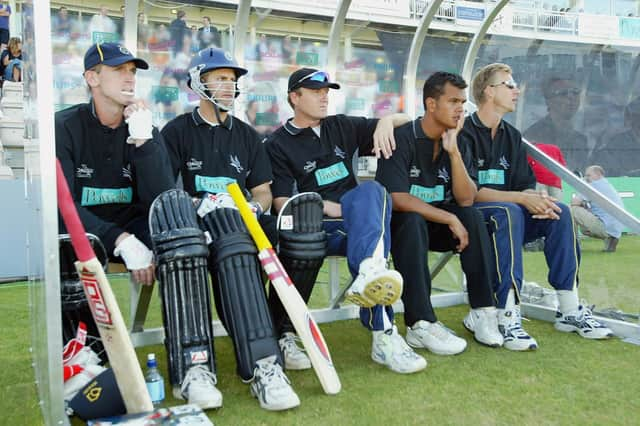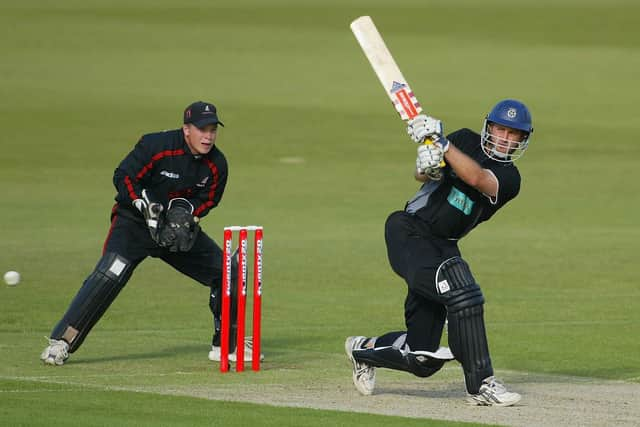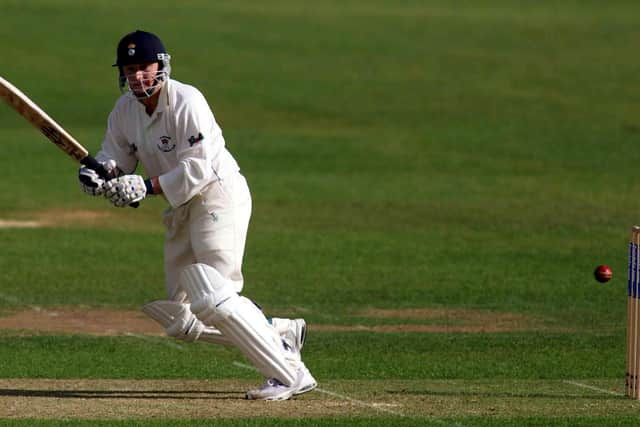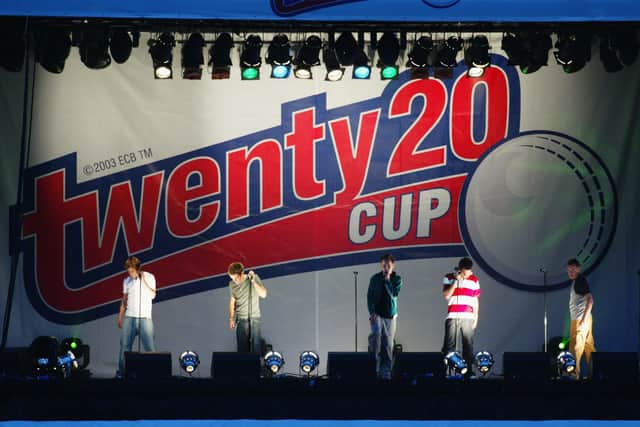It started with a wide – recalling Hampshire’s first match in the T20 format one player thought would be ‘a short-term fad’


It has introduced legions of new fans to the game, who in turn have packed out grounds across the planet and provided much-needed income.
It has created a new breed of cricketer - the ‘guns for hire’ brigade who will play anywhere in the world providing the salary is right.
Advertisement
Hide AdAdvertisement
Hide AdWhatever traditionalists might think, T20 cricket is now the most important of the three domestic county formats. Internationally, the same is true.


Counties can afford to lose the income generated by some Championship matches while lockdown continues.
The Royal London One-Day Cup could be sacrificed, and not many will be unduly concerned.
But the authorities are desperate to ensure that, if any county cricket is played this summer in front of crowds, it will be T20 taking centre stage. The bean counters at the 18 first class counties would all nod heartily in agreement.
Advertisement
Hide AdAdvertisement
Hide AdToday, Hampshire were due to lift the curtain on their 2020 campaign with a home match against south coast rivals Sussex.


It would have brought back memories of the first ever T20 meeting between the two counties, also on a Friday night at The Ageas Bowl, 17 years ago.
While other matches also took place that evening, the south coast derby was selected for live coverage on Sky and therefore began five minutes earlier.
Hampshire openers James Hamblin and Derek Kenway, therefore, faced the first few balls of the first ever T20 match to take place anywhere in the world.
Advertisement
Hide AdAdvertisement
Hide AdSussex’s James Kirtley bowled the very first over - and started with a wide.


In addition to the new format - half the length of the previous shortest format, the 40-over Sunday League - there were new innovations.
Sussex skipper Chris Adams, for example, found himself wired up and chatting to Sky commentator Charles Colville between deliveries.
There were also new team names, a nod to American sports - Hampshire had ‘Hawks’ added to their name, Sussex had ‘Sharks’. Elsewhere, say hello to the Sabres (Somerset), Gladiators (Gloucestershire), Phantoms (Derbyshire) and Spitfires (Kent - but surely given this county’s Spitfire links that should have been Hampshire’s nickname?)
Advertisement
Hide AdAdvertisement
Hide AdIn a bid to attract a younger audience, there were fairground rides and a concert featuring teen bands Misteeq and D'Side started after the match finished - they performed on a stage erected on the tarmac adjacent to the main oval and the Nursery Ground.
Hampshire were all out for 153 in the last over, with Sussex falling just short on 148-7 in reply.
Tim Ambrose had smashed 54 off 39 balls – the first T20 half century - and Sussex began their final over on 144 for six and favourites to win. But ex-England international Ed Giddins kept it cool and Hampshire triumphed.
Kenway top scored with 35 for the hosts - fellow opener Hamblin added 34 as Hampshire struck 66 runs in the first seven overs - while there were only two sixes hit in the entire game.
Advertisement
Hide AdAdvertisement
Hide AdThe vision of T20 had been dreamt up by ECB marketing manager Stuart Robertson and backed by the First Class Forum, a group made up of chief executives and chairmen from the 18 counties, in April 2002. Its creation meant the end of the road for the 55-over Benson & Hedges Cup, a regular feature on the domestic calendar since 1972.
Ahead of the Hampshire-Sussex tie, Robertson had said: ‘We clearly hope that the current supporters will find something in it but also lots of 16-34 year-olds, women and children, we want a large family attendance.
‘It's for people who are tolerant of cricket but have not yet been tempted over the line and the fact that it lasts less time and is full of entertainment means that it should give instant satisfaction.’
From the small acorns of that night on the outskirts of Southampton have grown a mighty financial oak - bringing lots of ‘instant satisfaction’, big money, big salaries and some even bigger hitting.
That has surprised many.
Advertisement
Hide AdAdvertisement
Hide Ad‘We just thought it was going to be a short-term fad,’ Kenway told The News this week.
‘We knew it was going to be a totally different thing, but we didn’t expect it to take off in the way it has.
‘But when you saw the crowds in the first season, you could see opinions changing - it was like ‘hang on, this could have some sort of longevity.
‘Now it’s probably put a strain on the other formats, people are probably waiting to go and watch T20 rather than some of the other stuff.’
Advertisement
Hide AdAdvertisement
Hide AdHampshire’s 153 debut total wasn’t a bad one. It was actually more than the county scored in home games against Sussex in 2017 (126-9) and 2018 (138-7).
But it has certainly been dwarfed by many others - Hampshire have rattled up 10 scores of over 200 since 2003.
In the 2017 quarter-final, Shahid Afridi’s eye-popping 43-ball 101 helped Hampshire amass 249-8 at Derbyshire - the third highest team total in English T20 history.
It was only four short of equalling Gloucestershire’s record 253-4 total against Middlesex at Uxbridge in 2011.
Advertisement
Hide AdAdvertisement
Hide AdCompare those scores to the 208-7 Leicestershire scored in the 1992 NatWest Trophy final off 60 overs, or the 232-6 Kent scored in the 1984 NatWest final off the same amount of balls, and you easily see how T20 scoring has revolutionised one-day cricket.
The knock-on effect to the 50-over game has been astonishing. Of England’s 14 highest ever ODI totals, for example, only one was scored before 2015 - and that was in 2005.
In a Royal London Cup tie four years ago, both Nottinghamshire and Northants scored over 400 at Trent Bridge.
Of Hampshire’s highest ever 15 List A innings, only two were scored prior to their first T20 game - both in 60-over games and one against Berkshire.
Advertisement
Hide AdAdvertisement
Hide AdHampshire’s highest ever one-day score is their 371-6 total in the Gillette Cup against Glamorgan in 1975. The run rate that day was 6.18 runs per over. In the 2017 T20 quarter final at Derby, Hampshire averaged 12.45 runs per over - more than double the Glamorgan rate.
Kenway said the Hampshire players did train specifically for the advent of the T20 format – but in many ways were in the dark.
‘We practised range hitting - standing in the middle and trying to hit the ball out of the ground,’ he recalled.
‘We had talks about how to play T20 - would the team who hit the most boundaries win, or would it be the team who hit the most twos?
Advertisement
Hide AdAdvertisement
Hide Ad‘We didn’t really know what to do, as it was completely alien to us.
‘Things like fast hands were not something we ever discussed. We were built and designed to play the longer format - some of us were better at the one-day stuff than others.
‘We had some very good hitters - Robin Smith, Dimi Mascarenhas, James Hamblin - but nothing compared to what you see today.’
Many will have forgotten, but there was nothing like the 14-match group campaign we know today back in 2003.
Advertisement
Hide AdAdvertisement
Hide AdThe 18 counties were placed in three groups of six and played the other sides just once, giving them just five matches to make an impression.
Hampshire’s opening win would prove to be their only one of the inaugural event - they lost the next four.
But very quickly there was no doubting T20 had caught the public’s imagination.
The poor cricket attendances in the late 1990s that had alarmed the game’s authorities and forced their hand in coming up with something new were certainly not a problem in T20 – fans, especially younger ones, came in droves and kept coming back for more.
Advertisement
Hide AdAdvertisement
Hide AdThe number of games grew - even in 2004, although the group stage still only allowed for five matches, the number of teams qualifying was doubled from four to eight to allow for quarter-finals.
Hampshire were one of those teams, having lost their first two group games in 2004 before winning their next three. But a comfortable home loss to Lancashire wrecked their chances of a first Finals Day appearance.
The county would have to wait until 2010 for that - a memorable day as Hampshire won the tournament on their home ground.
Hampshire lifted the trophy again two years later, and there have been five other Finals Day appearances - as losing semi-finalists in 2011, 2013, 2014, 2015 and 2017.
Advertisement
Hide AdAdvertisement
Hide AdNo other county has made more appearances on Finals Day, and only Leicestershire (3) have won the tournament more times than Hampshire.
The waiting goes on to see if they will be given a chance to extend their enviable record in Twenty20 in 2020 ...